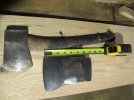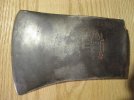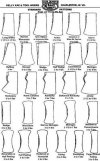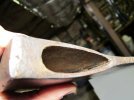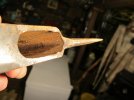- Joined
- Mar 12, 2011
- Messages
- 214
Here's a couple new arrivals. The little guy is unmarked but hand forged, found it in a junk store in Maine. The handle is pretty beat up but feels great in balance with the head. It's really thin and has kind of a back sweep that I like. I'm going to try to duplicate it with a drawknife, a spindle sander, and a piece of a bigger handle. The Kelly Works is the one I'm curious about. It also looks hand forged and is an older line. The other side has just a True Temper stamp. Looking at the one old Kelly axe pattern sheet I could find I thought it might be a New England pattern (and that's where it came from), but it's obviously a little difficult to distinguish between a lot of those patterns. Thoughts?
